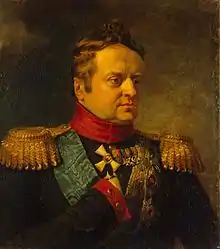Duke Alexander of Württemberg (1771–1833)
Duke Alexander of Württemberg (Mömpelgard/Montbéliard, then Württemberg (now France), 5 May 1771 – Gotha, Thuringia, Germany, 4 July 1833)[1] was a Duke of Württemberg. The son of Frederick II Eugene, Duke of Württemberg and of Sophia Dorothea of Brandenburg-Schwedt. His sister Sophie Dorothea married Tsar Paul I of Russia.[1]
Duke Alexander of Württemberg | |
|---|---|
 Portrait by George Dawe, 1823 | |
| Born | 5 May 1771 |
| Died | 4 July 1833 (aged 62) |
| Allegiance | Armies of Württemberg, Austria and Russia |
| Service/ | Army |
| Years of service | 1791-1832 |

Family
In 1798 he married Antoinette of Saxe-Coburg-Saalfeld (1779 - 1824). They had five children:
- Marie of Württemberg (1799–1860), who in 1832 married Ernest I of Saxe-Coburg-Gotha.
- Paul of Württemberg (1800–1801)
- Alexander of Württemberg (1804-1881), Duke of Württemberg
- Ernest of Württemberg (1807–1868), Duke of Württemberg, who in 1860 married Nathalie Eschborn, later ennobled as "von Grünhof" (1829–1905) :
- Alexandra Nathalie Ernestine von Grünhof (Wiesbaden, 10 August 1861 - Hohenlübbichow, 13 April 1933), who in 1883 married Robert von Keudell
- Friedrich Wilhelm Ferdinand of Württemberg (Saint Petersburg 29 April 1810 - Saint Petersburg, 25 April 1815)
Descendants
Alexander of Württemberg was the founder of the fifth branch (called the ducal branch) of the House of Württemberg, as the seventh son of Frederick II Eugene, Duke of Württemberg. On the extinction of the eldest branch in 1921, the ducal branch became the new dynastic-branch of the House. (The House of Württemberg's two morganatic branches - the dukes of Teck (extinct in the male line in 1981), and the morganatic branch of the dukes of Urach - were technically 'older' than the Ducal branch, but ineligible to succeed).
Alexander of Württemberg is the direct ancestor of the present claimant to the dukedom of Württemberg, Carl.
Ernest's descendant, a German therapist named Karin Vogel, was last in line of succession to the British Throne as of 2011.[2]
Military service
Austria
Alexander began service in the Württemberg army as a colonel on 21 April 1791, and transferred to the Austrian army, serving during the campaign against France in 1796-1799, and participating in the battles of Rastadt, Würtzburg, Offenbach, Stockach and Zurich.[1] In 1796 Prince Alexander became a Major General and a Fieldmarshal Lieutenant in the Austrian army in 1798.
Russia
In that year he met Alexander Suvorov, and took up his recommendation to join the Imperial Russian Army as a Lieutenant General and chief of the Riga Cuirassier Regiment which in August 1800 was reorganised into Riga Dragoon Regiment while Alexander was promoted to General of Cavalry (the rank below Field Marshal). In 1811 he was appointed Military Governor of Belorussia.[1]
During the 1812 Campaign Württemberg served at the Headquarters of the 1st Western Army and fought at Vitebsk, Smolensk, Borodino, Tarutino (awarded Order of St. George, 3rd class), Maloyaroslavets, Vyazma and Krasnoi.[1] In 1813 he commanded the Siege of Danzig for which he was awarded a golden sword and the Order of St. George (2nd class). After the war he returned to Belorussia and his Riga Regiment.
In 1822 he became the Head of the Communications Department (responsible for transport links) and initiated several large-scale waterway projects (the Windawski Canal, etc.) in western Russia.[1][3] In 1826 Württemberg was appointed chief of Ekaterinoslav Cuirassier Regiment, and a member of the State Council, but returned to the Riga Dragoons in 1827. In 1832 he resigned from military service and left Russia on 24 November, never to return.[1]
Awards and decorations
 Württemberg:[4]
Württemberg:[4]
- Knight of the Golden Eagle
- Commander of the Military Merit Order, 2nd Class, 1799
 Russian Empire:[5]
Russian Empire:[5]
- Gold Sword for Bravery, inscribed "For capture of Danzig"[1]
- Knight of St. Andrew, in Diamonds, 28 June 1798
- Knight of St. Alexander Nevsky, 28 June 1798
- Knight of St. Anne, 1st Class, 28 June 1798
- Grand Commander of St. John, 28 June 1798
- Knight of St. George, 3rd Class, 1812; 2nd Class, 12 November 1813
- Knight of St. Vladimir, 1st Class, 25 February 1813
.svg.png.webp) Kingdom of Prussia:
Kingdom of Prussia:
- Knight of the Black Eagle, 15 January 1814[6]
- Knight of the Red Eagle, 2nd Class
.svg.png.webp) Kingdom of Bavaria: Order of Maximilian Joseph
Kingdom of Bavaria: Order of Maximilian Joseph.svg.png.webp) Sovereign Military Order of Malta: Bailiff Grand Cross
Sovereign Military Order of Malta: Bailiff Grand Cross
See also
- Karl Alexander, Duke of Württemberg (his paternal grandfather)
- Frederick William of Brandenburg-Schwedt (his maternal grandfather)
Ancestry
References
- p.448, Mikaberidze
- Lewis, David. "Persons eligible to succeed to the British Throne as of 1 Jan 2011". wargs.com. Archived from the original on 17 May 2011.
- Александр герцог Виртембергский (in Russian). Retrieved July 2, 2011.
- Württemberg (1815). Königlich-Württembergisches Hof- und Staats-Handbuch: 1815. Guttenberg. pp. 13, 17.
- Almanach de la cour: pour l'année ... 1817. l'Académie Imp. des Sciences. 1817. pp. 62, 77, 90, 148.
- Liste der Ritter des Königlich Preußischen Hohen Ordens vom Schwarzen Adler (1851), "Von Seiner Majestät dem Könige Friedrich Wilhelm III. ernannte Ritter" p. 17
Notes
- Mikaberidze, Alexander, The Russian officer Corps in the Revolutionary and Napoleonic wars 1792-1815, Savas Beatie, New York, 2005
External links
| Wikimedia Commons has media related to Duke Alexander of Württemberg. |